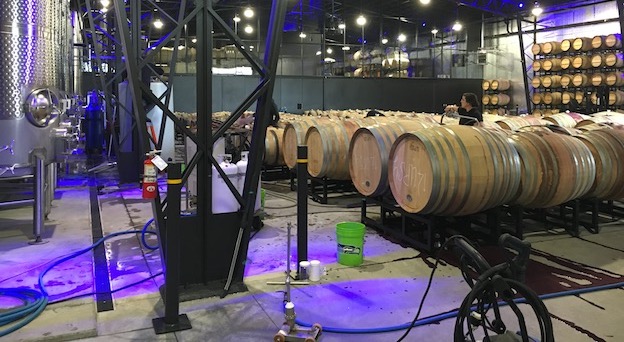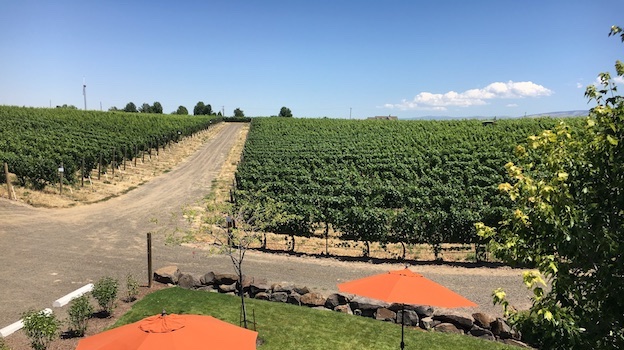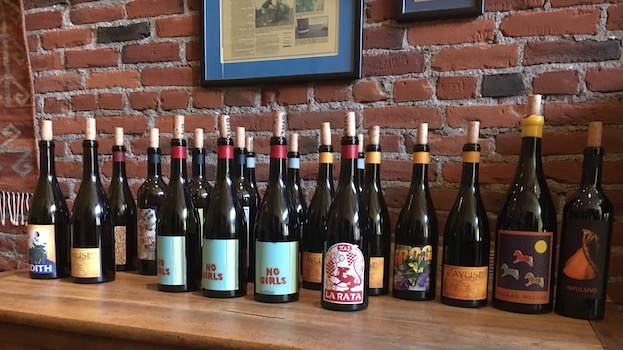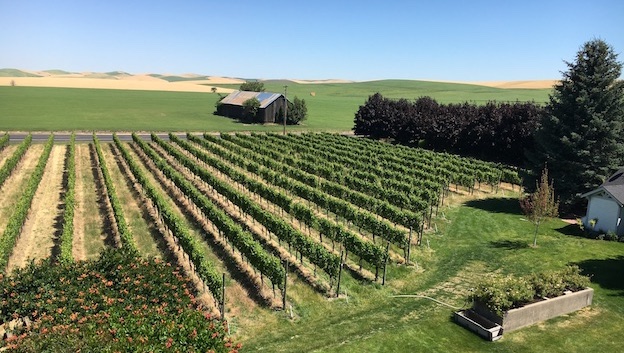Browse using the new Vinous website now. Launch →
Printed by, and for the sole use of . All rights reserved © 2015 Vinous Media
Focus on Washington: Hot Times in the Desert
BY STEPHEN TANZER | NOVEMBER 29, 2016
As desert-dwellers, Eastern Washington’s grape growers and the winemakers who love them have always had strategies for dealing with hot, dry weather. The Washington wine industry is built on irrigation, and its cleverest players have continually sought out less extreme sites to plant their vines—cooler expositions, higher elevations, more water-retentive soils—as well as dramatically improved their selections of clones and rootstocks to match their various sites.
Washington State AVA Map courtesy of Washington State Wine. Click for high resolution version
But the extreme heat in 2013, 2014 and 2015, with each growing season warmer than the last, required growers and makers alike to get much more creative with the vineyards that currently supply their fruit and with the way they handle their raw material when it reaches the winery.
A Brief Recap of the 2013 and 2014 Growing Seasons
Following three years that were cool, downright chilly and moderate, respectively, the heat returned in 2013. The spring was actually cool and long, and the flowering was late, but the second half of July and the month of August were blistering hot. The harvest began in a rush under torrid conditions in early September, with most white varieties, Merlot and some Syrah often brought in with shriveled grapes and overripe flavors. But a sustained cool-down in the second half of September and early October allowed harvesters to take a break and let their fruit hang for better phenolic maturity, without potential alcohol levels going through the roof or natural acidity levels dropping precipitously.
Two thousand fourteen was then a consistently hot growing season virtually from start to finish, breaking records for total heat accumulation in most growing areas in eastern Washington. Some growers pointed out that the vines were acclimated to the heat early on, and that there were fewer extreme heat spikes than in 2013, but others noted that sustained periods with temperatures in the low 90s, during which the vines continue to work and don’t quite reach the shut-down point, were more likely to result in overripe flavors, not to mention higher pHs. And, in general, there was more heat after veraison in 2014 than there had been the previous year.
The Record-Shattering 2015 Vintage
Washington went from the frying pan of 2014 to the fire in 2015, although most growers maintain that it was a healthy burn. The warmth arrived freakishly early, with Growing Degree Days (a measure of total heat accumulation based on the amount by which each day’s average temperature exceeds 50 degrees Fahrenheit) beginning in February. Bud break, flowering and harvest were all two to three weeks ahead of normal. Most growers had their earliest harvest starts ever, beginning in mid-August, and many finished by the end of September, which is also extremely rare in eastern Washington, where the harvest in cool years can stretch into November. There were long periods during the summer with temperatures in the mid to upper 90s in the warmer sites, and more 100+ days than in any previous year. As the vines tend to shut down when afternoon temperatures exceed 95 degrees, the stultifying heat actually extended the growing season a bit, and moderating temperatures in late August and September made the harvest less of a mad rush. One of the keys to the concentration, deep colors and style of the 2015 reds was the small size of the grapes, with the brutal heat of July particularly instrumental in suppressing berry size.

Charles Smith's new high-tech cellar north of Boeing Field in Seattle
Three Potentially Excellent Years, though Opinions and Results Vary
It is clear that 2013, 2014 and 2015 all provided the raw materials to make outstanding wines, although 2015 appears to have been a tough year from which to make vibrant, balanced white wines in the warmest areas, and the early-picked varieties in 2013 offered distinctly mixed quality. Interestingly, growers’ opinions are split on the merits of 2013 and 2014. While the majority of the winemakers I tasted with this summer or communicated with in recent weeks admit that the 2014s are more likely to show roasted aromas or signs of dehydrated berries, many also say they prefer this vintage to 2013 for its greater ripeness combined with surprisingly good balancing acidity. A few reported that their 2013s are more likely to show overripe aromas. But it’s important to note that most winemakers do not feel that either of these years is characterized by excessive overripeness. And those who work high-altitude vineyards often consider both of these vintages to be relatively easy years.
Nina Buty (Buty Winery) noted that “at the same sugar levels of the juice, the 2014 wines held a little more acidity, while the 2013s, as a general rule, seem to show a bit more tannin.” Chris Figgins (Leonetti Cellar, FIGGINS) took a longer view, noting that the recent increases in total heat units have partly occurred early in the season, resulting in early bud breaks, earlier flowering and, obviously, earlier harvest dates. In fact, he added, “because we’ve been picking earlier, a good bit of the total heat unit accumulation has actually occurred after we harvested.” He went on: “In my opinion, 2009 and 1998 were much hotter than 2013, 2014 and even 2015 both in terms of extreme high temperatures and the resulting wines. In fact, 2009 stands out in my mind as the one vintage that had overt alcohol and extra-ripe characteristics.”
And of course Figgins and many of his colleagues in the desert are far more clever today about managing their vineyards to deal with heat spikes than they were in the late ‘00s, to say nothing of the late ‘90s. “The 2013s are a bit angular while the ‘14s are more user-friendly wines,” he summarized. Chris Gorman (Gorman Winery), who works mostly with fruit from the very warm, dry Red Mountain AVA, added, “Funny, I don't think of 2013 and 2014 as being unusually ripe or hot.” And David Larsen (Soos Creek) noted: “I have no complaints about 2013, and 2014 was even better for us. Overripeness and cooked fruit seem to be associated with long hang time. But we try to pick on the early side to avoid those issues.”
Marty Clubb of L’Ecole No. 41 contended that total heat units are less important than heat units between veraison and harvest. He explained the differences between 2013 and 2014 this way: “Two thousand thirteen stayed hotter than usual through mid-September, and then dramatically cooled off. Sugars were normal, not high, but acids were slightly lower, particularly for later-maturing Cabernet Sauvignon. While 2014 was overall hotter, we had near-normal temperatures in mid-August and early September, resulting in better balance, both in terms of phenolic structure and acids.”
Chris Peterson, who makes the Passing Time wines as well as his own Avennia label, views the 2014s as “bigger wines, with sweeter fruit than the 2013s. The pHs were higher in 2013 but grape sugars were lower, and the vintage drinks cooler than 2014.” Bob Betz (Betz Family Vineyards) similarly described the 2013s as “more delicate, cerebral and sharply chiseled,” adding that the 2014s are richer and higher in dry extract. Ben Smith of Cadence noted that "the ‘13s have the acidity, thrust and structure to appeal to the Euro crowd.” But Brennon Leighton (B. Leighton, Sixto), believes that the phenolics are less mature and complex in the ‘13s than in the ‘14s. A majority of winemakers agree that the 2014s will show well earlier than the ‘13s.
And 2015 is in a Category of its Own
Although I only tasted a few early-bottled 2015 reds, with the biggest wines of the vintage at least a year away from hitting the retail market, the superlatives were flying this summer. David Larsen considers 2015 to be Washington’s best vintage since 1999, largely due to the extremely small berry size. “Despite the heat and the early harvest, the grapes had excellent flavors with acceptable levels of sugars and acids,” he told me, with the qualifier that early picking probably helped. Peter Devison (EFESTÉ) noted that “the 2015s are big, rich wines with an abundance of ultra-ripe tannins and a lot of ‘fruit weight,’” but he was also concerned that some vineyards or fruit lots lack the tension to give them ageability. Casey McClellan (Seven Hills Winery) considers the 2015s to be “quite extravagant and hedonistic—a challenging but fun vintage to work with.” Nina Buty pointed out that the early heat of 2015 “didn’t necessarily translate into more ripeness—it just woke the vines up earlier. So while 2015 has high overall Growing Degree Days, that warmth didn’t all translate into sugar levels in the grapes.” In sum, most growers agree that 2015 produced large-scaled, opulent wines that will give pleasure relatively early, but some said it was just too hot to make vibrant white wines. Said Anna Schafer (àMaurice Cellars): “It was so hot that white grapes often ripened on one side of the vine but not the other.”

Vines in Va Piano's home vineyard
A Glance at 2016
Following the record heat of 2015, growers had major fears about 2016, as an unusually warm winter and a toasty spring led to the earliest flowering in history. Heat accumulation figures at that point were well ahead of those of ’15, and many growers were resigned to starting their harvest in mid-August. But there were a couple spells of temperate weather in mid-June and in July (not during my time in Walla Walla Valley, sadly), and conditions turned much more moderate in early August. The harvest began early but was long and leisurely, going on for six weeks or more for some producers and lasting through late October. The fruit enjoyed the benefits of long hang time without high potential alcohol or plunging acidity levels, and many growers are already quite excited about the vintage. Clearly, harvest conditions were much more favorable for white grapes than they were in 2015.
Dealing with the Challenge of Heat
I asked most of the winemakers I visited this summer, plus some that I didn’t, to name their biggest challenge during the recent hot years, as well as the steps they’ve taken to respond, both in the vineyards and winery. Gilles Nicault (Long Shadows Vintners Collection) succinctly described the chief challenge as “sunburn on the berries and the potential early sugar spike before flavor development and full physiological maturity.” Andrew Trio (Corliss Estates, Tranche), who seeks a more ageworthy claret-like style, described the same issue from a slightly different standpoint: “Our main challenge was achieving dense, ripe, supple tannins while maintaining a cool, herbaceous character and a dark spectrum of fruit.”
Needless to say, canopy management and strategic use of irrigation were mentioned by most respondents as ways to slow down ripening as well as to prevent sunburn on the grapes and serious blockage of maturity. David Larsen told me he has responded “by shading [his] fruit better, with more leaves and better watering practices, including misting with water to cool down the vines.” Kendall Mix told me his biggest challenge has been to convince his growers ”to increase irrigation to support more foliage on the afternoon side of the plants to avoid excessive sunburn.” Said Marty Clubb: “In the vineyards we delayed thinning and leaf pulling in order to delay veraison as much as possible. Sunburn is an issue, and too much west-side burn lowers anthocyanin development and results in poorer color.”
Another key in hot years with early flowering is to push the final ripening period later into September. “The key is to grow healthy vines that do their final ripening in late September and early October, since high temperatures generally do not occur up here past mid-September,” explained Paul Golitzin (Quilceda Creek). Kendall Mix (Cadaretta, Lawrelin) added: “I think slightly larger crops also allow us to disperse sugar accumulation into a larger sink, which gives time for flavor development to catch up.” Christophe Baron (Cayuse Vineyards, No Girls, Horsepower), a pioneer in biodynamic farming in eastern Washington, noted that this approach is especially constructive in hot years as it “allows for better phenolic ripeness at lower levels of potential alcohol—not to mention better-balanced wines in general.”
I will give Billo Naravane (Rasa Vineyards, Echo Ridge Cellars) the last comprehensive word on how to make balanced wines in especially hot years in the desert. “In my opinion, in 2013, 2014 and 2015, proper vineyard management was absolutely essential,” he said, “and it was possible to make some terrific, well-balanced wines in all three vintages provided that appropriate steps were taken. For the vineyards that I consult for and for the vineyards from which we source fruit for Rasa, I closely track the heat unit summation until the end of June or mid-July. In the 2013 through 2015 vintages, since the heat summation was ahead of schedule we took aggressive steps to slow down the ripening. We kept a slightly higher fruit load than normal; instead of 2 tons per acre, we cropped at 2.3 to 2.5 tons, depending on the vigor of the site. And we reduced the overall canopy by 25% to 35%--fewer leaves equals less photosynthesis equals less sugar accumulation. We were careful not to leaf-strip too much in the fruit zone, in order to prevent sunburning of fruit. And we also kept the vines under a moderate level of water stress; in hotter years I don’t like high levels of water stress because a sudden heat spike may cause serious damage to the vines.
“If these steps were followed, it was possible to slow down the sugar accumulation so that it better aligned with flavor and phenolic maturity. That being said, I know a lot of vineyards where the appropriate measures were not taken. This resulted in very high sugar levels in the grapes with little to no flavor development; the wines made from such grapes will lack any depth or complexity. I think consumers will have to be quite cautious in their wine selections in these years to avoid overripe character with low acidity. And I would fully expect to see more surmaturité character in 2015 than in 2014, and in 2014 vs. 2013.”

A feast of riches in the Cayuse tasting room
Questioning Received Wisdom
In fact, very low crop levels in the desert do not always produce the best-balanced wines. Hanging a larger crop is one way to slow down the uptake of sugar in the grapes and allow for better phenolic maturity, as the hot years are capable of ripening much more fruit than the cooler seasons that begin with a later flowering. Some winemakers and growers avoid excessive thinning of the grapes early in the season, especially in the recent years featuring very early flowering. Said Sean Boyd (Rotie Cellars): “Gearing up for hot growing seasons means starting crop loads heavier and green harvesting just before the heat waves dissipate, then encouraging concentration of the fruit during the rest of the season. Explained Jeff Lindsay-Thorsen (W. T. Vintners): “Hanging a bit heavy early on diffuses some of the vines’ energy and slows ripening.”
Similarly, long hang time of the grapes in the desert does not necessarily bring better balance. Many winemakers are picking earlier, favoring acid retention and fresher fruit character over complete tannin ripeness. As Chris Upchurch (DeLille Cellars, Upchurch Vineyard) put it: “Don't be afraid of some tannins. If you wait for tannins to soften too much then you will favor overripeness. Tannins can be naturally resolved in the cellar. We don’t wait to harvest. If the underripe and green qualities are gone, then the fruit is ripe. Red, blue and black fruits are fine; it doesn’t matter—just nothing green.” David Larsen added that cooked-fruit aromas and dehydrated grapes “are attributes that seem to be associated with long hang time,” which is not necessarily the case in cooler wine regions. And more and more Washington winemakers are purposely using slightly underripe, early-picked fruit as a natural acidifier to freshen their wines, of particular utility in a wine region where acidification is widely necessary. (Similarly, as raisiny or port-like flavors are harder to hide in a blend than less-than-optimal skin ripeness, the best winemakers are now especially careful to eliminate overripe lots from their wines.)
Aryn Morell (Gard Vintners, Ardor Cellars, Mullan Road Cellars, Tenor Wines, Matthews Winery, Morell-Lawrence) told me he picks in waves. “We’ve decided that in the recent hot years, flavor development—or, more accurately, overdevelopment—was going to be harder to overcome during production if the grapes were picked at physiological maturity than it would be to pick with the ideal flavor profile based on the season and have the fruit be less physiologically mature.” He added that fruit from warm seasons is “going to show riper tendencies even if it’s picked slightly earlier” and he worries that too many of his colleagues in the recent hot years “don’t think the flavor or the phenolic maturity is quite there, so they wait. But in many cases, in hot, fast growing seasons the fruit will never really have enough time to achieve ideal physiological maturity anyway.” He believes that he can pick slightly earlier and still have “the best chance for aromatic complexity and youthfully fresh fruit,” because his new winery facility and equipment lets him manage the slightly more aggressive tannin profile that his fruit begins with.
(Analogously, a growing number of red Burgundy producers feel that it’s a lot easier to add sugar to fermenting must—and even to deal with slightly underripe phenolics—than it is to somehow eliminate or even mask raisiny, shriveled-fruit character in their wines once they allow their grapes to get too ripe.)

Abeja's Mill Creek Estate vineyard, on the northeast side of Walla Walla
More Precise Picking and Sorting
Timely harvesting is also critical in the hot years, and is facilitated by smaller-lot fermentations. Clearly, very selective picking to avoid desiccated clusters, careful elimination of raisined fruit in the winery, and declassification of overripe lots can make the difference between producing wines with a roasted character and those with fresh aromas and flavors. If it’s necessary to harvest when the weather is still hot, many growers and wineries pick very early in the morning, when the grapes are still reasonably cool. And of course, steps taken throughout the growing season to slow down the ripening process can also alleviate the logistical challenges posed by compressed harvests and reduce the likelihood that normally early-ripening varieties will need to be picked under uncomfortably warm conditions at the end of August or in early September.
The wines in this article were tasted in Washington during the last week of June and the last week of July, and in extensive subsequent tastings (and retastings) in New York from late September through early November.
You Might Also Enjoy
Washington Turns Up the Heat, Stephen Tanzer, November 2015
New Releases from Washington State, Stephen Tanzer, December 2014
Show all the wines (sorted by score)
- Abeja
- Alder Ridge
- àMaurice Cellars
- Amavi Cellars
- Analemma Wines
- Andrew Will Winery
- Ardor
- Array Cellars
- Ashan Cellars
- Avennia
- Baer Winery
- Barons Winery
- Basel Cellars
- Betz Family Vineyards
- B. Leighton
- Boudreaux Cellars
- Brian Carter Cellars
- Browne Family Vineyards
- Buty Winery
- Cadaretta
- Cadence Winery
- Canoe Ridge Vineyard
- CasaSmith
- Cayuse Vineyards
- Charles Smith Wines
- Chateau Ste. Michelle
- Co Dinn Cellars
- Col Solare
- Columbia Crest Winery
- Corliss Estates
- Côte Bonneville
- Côté Nicault
- DeLille Cellars
- Delmas
- Den Hoed
- Doubleback
- Dowsett Family Winery
- Dunham Cellars
- Echo Ridge Cellars
- EFESTÉ
- Eight Bells
- Figgins
- Five Star Cellars
- Force Majeure
- Forgeron Cellars
- Gard Vintners
- Gorman Winery
- Gramercy Cellars
- Guardian Cellars
- Hightower Cellars
- Horsepower
- Idilico
- Januik Winery
- JB Neufeld
- Kerloo Cellars
- Kevin White Winery
- K Vintners
- La Rata
- Lauren Ashton Cellars
- Lawrelin
- L’Ecole No. 41
- Leonetti Cellar
- Lobo Hills
- Long Shadows Vintners Collection
- Mackey Vineyards
- Maison Bleue
- Mark Ryan Winery
- Matthews Estate
- Morell-Lawrence
- MTR Productions
- Mullan Road Cellars
- No Girls
- Northstar
- Nota Bene Cellars
- Novelty Hill
- Orr Wines
- Owen Roe
- Passing Time
- Pepper Bridge
- Pomum Cellars
- Proper Wines
- Quilceda Creek Vintners
- Rasa Vineyards
- Reininger Winery
- Reynvaan Family Vineyards
- Ross Andrew Winery
- Rôtie Cellars
- Saviah
- Secret Squirrel
- Seven Hills Winery
- Sixto Wines
- Sleight of Hand Cellars
- Soos Creek Wine Cellars
- Sparkman Cellars
- Spring Valley Vineyard
- Tamarack Cellars
- Tenet Wines
- Tenor
- The Walls
- Three Rivers Winery
- Tranche
- Trust Cellars
- Two Vintners
- Upchurch Vineyard
- Va Piano Vineyards
- VINO
- Waitsburg Cellars
- Waters Winery
- Wines of Substance
- Woodinville Wine Cellars
- Woodward Canyon Winery
- W.T. Vintners

